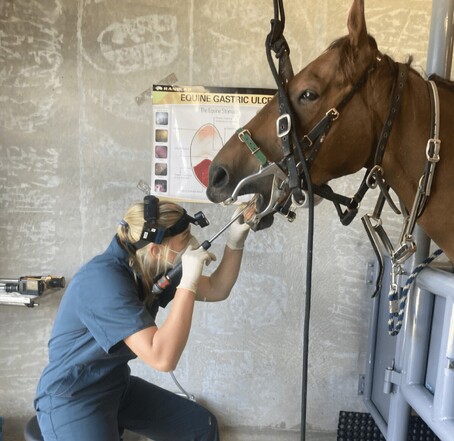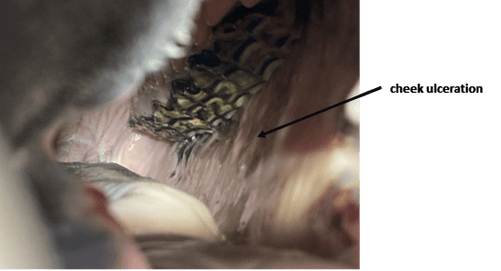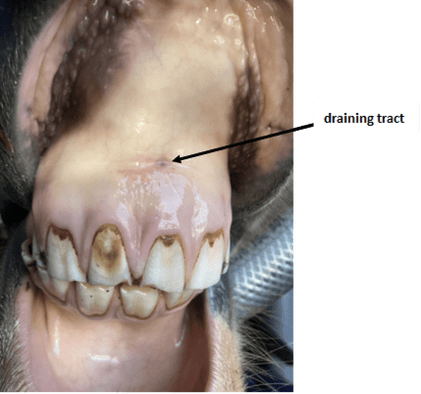Dental disease is one of the most common reasons that your horse may need to see the vet.
Horse’s teeth continually erupt throughout their lifetime, which means that regular dentistry is essential to prevent and identify problems.
Young horses
Like humans, horses have deciduous (baby) teeth before they get their full set of adult teeth. By the age of five, horses have between 36 and 40 teeth, as canine and wolf teeth are not always present.
This is a critical stage of dental development and regular dental checks enable identification and prevention of any tooth eruption problems, malocclusion, misalignments or ‘retained caps’ (deciduous teeth that have not shed).
As young horses' teeth are softer than older horses', they are more likely to develop sharp enamel points which can lead to painful ulceration and cuts in their mouths. Therefore, bi-annual dental examinations are strongly recommended for younger horses. These can be started when they are yearlings.
Wolf teeth
Wolf teeth are a common cause of concern for horse owners, however, contrary to popular belief, they do not often cause a problem unless they are fractured or blind.
However, a lot of owners prefer them to be removed in case they cause a problem, as they can sometimes interfere with the bit.
Dentistry from the age of 5 onwards
As horses get older, they are more prone to dental disease impacting their quality of life and their ability to keep weight on. Regular dentistry from an early age can prevent problems developing and prolong their life without dental pain.
Annual dental checks by your vet are essential in preventing dental disease developing down the line.
Unfortunately, domestication of the horse has led to this requirement due to diet and management changes. Stabling and grain-based diets have become the norm for many of our horses, which means continuously erupting teeth are not worn down adequately, leading to overgrowths and uneven wear.
Furthermore, breeding horses based on traits linked to performance may have inadvertently selected those more likely to develop dental disease.
Routine dentistry involves a full dental examination under sedation, enabling us to effectively use a dental mirror to visualise the teeth.
Problems such as diastema (food packing in between teeth) may be identified. If left untreated, this can lead to periodontal disease and apical tooth root infections, which in many cases require extraction.
As only the crowns of the teeth are visible in an oral examination, radiography is often recommended to assess the tooth roots and sinuses of the horse when disease is identified on dental examination.
As the tip of the iceberg analogy goes, we don’t know what is going on under the surface! Furthermore, the former conditions will cause pain in the mouth, leading to uneven wear.
In most cases, routine dentistry involves ‘rasping’ or ‘floating’ of sharp enamel points, as well as reduction of overgrowths and hooks created due to misalignment of the mouth.
What to watch out for
Horses are stoic animals. They may have a painful periodontal disease, but continue to eat, and they adapt, which may mean their pain goes unnoticed.
However, there are hallmark signs to watch out for, including:
Loss of feed while eating, colloquially known as ‘quidding',
Excessive salivation,
Weight loss,
Undigested feed particles in faeces,
A foul odour,
Traces of blood from the mouth or nasal discharge and swelling of the face or jaw.
Signs can also be more subtle and your horse may just not be performing to their best. It may be that they are head tossing, chewing, or resisting the bit. Unfortunately, quite often, none of the former signs are present and issues are only identified during dental exams.
EOTRH
Equine Odontoclastic Tooth Resorption and Hypercementosis (EOTRH) is a common condition affecting the incisors and canines of geriatric horses.
Although this disease commonly affects older patients, it has been reported in younger horses.
A simple carrot or apple test, which determines whether you horse has incisor pain, may be helpful. If they struggle to bite into a carrot or apple, this may be an indication that something is wrong.
Clinical signs can range from mild to severe and this disease is degenerative as horses age. Incisor gum recession, caries, fractures and draining tracts (which can appear only as a small pinpoint) are all signs of EOTRH.
However, your horse may have incisor pain without the former signs which is why the carrot test is so important.
Diagnosis is made radiographically and the treatment for this disease is extraction - removing the source of the pain.
Feeding soft foods and avoiding hay is also recommended.
Maintaining overall health and wellbeing
Preventing and identifying potential problems in your horse’s mouth is an important part of their overall health and wellbeing.
Annual dental checks allow your vet to identify any possible issues your horse may have, or may develop, meaning these can be treated early before long-term problems or permanent damage occurs.



